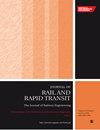GERALD: A novel dataset for the detection of German mainline railway signals
IF 2.1
4区 工程技术
Q3 ENGINEERING, CIVIL
Proceedings of the Institution of Mechanical Engineers Part F-Journal of Rail and Rapid Transit
Pub Date : 2023-04-03
DOI:10.1177/09544097231166472
引用次数: 2
Abstract
In recent years, a strong push towards driverless mobility solutions can be seen in many transportation sectors including railways. While the European Train Control System already specifies the necessary interfaces to open up the possibility of Automatic Train Operation (ATO) for mainline railway vehicles, required infrastructure-side upgrades of interlocking systems are time- and cost-intensive. Alternatively, a pure vehicle-side Automatic Train Operation solution can be conceptualized that relies on processing the same audio-visual input a human train driver would normally base his decisions on. This would require the vehicle-side detection of track-side railway signals to determine the vehicle’s movement authority and allowed maximum speed. Such a signal detection system could furthermore be employed as an Advanced Driver Assistance System (ADAS) or support autonomous shunting operations. To enable such a system, this paper presents GERALD, a novel dataset for a neural network based detection approach of railway signals. The dataset contains 5000 images from a wide variety of railway scenes as well as annotations for the most common types of German mainline railway signals. The material was gathered using publicly available cab-view recordings uploaded by railway enthusiasts on YouTube. Using a state of the art neural network architecture for evaluation, we notice promising detection accuracies despite GERALD being a comparably small dataset. The dataset is freely available for research and non-commercial purposes at: https://github.com/ifs-rwth-aachen/GERALD杰拉尔德:一个新的数据集,用于检测德国干线铁路信号
近年来,包括铁路在内的许多交通部门都在大力推动无人驾驶出行解决方案。虽然欧洲列车控制系统已经规定了必要的接口,为干线铁路车辆开启自动列车操作(ATO)的可能性,但所需的联锁系统基础设施方面的升级是时间和成本密集型的。或者,一个纯粹的车辆侧自动列车操作解决方案可以概念化,它依赖于处理与人类火车司机通常基于他的决定相同的视听输入。这将需要车辆侧检测轨道侧的铁路信号,以确定车辆的移动权限和允许的最大速度。这种信号检测系统还可以用作高级驾驶辅助系统(ADAS)或支持自动调车操作。为了实现这样一个系统,本文提出了GERALD,这是一个基于神经网络的铁路信号检测方法的新数据集。该数据集包含来自各种铁路场景的5000幅图像,以及最常见的德国干线铁路信号类型的注释。这些材料是由铁路爱好者在YouTube上上传的公开的车厢视图记录收集的。使用最先进的神经网络架构进行评估,尽管GERALD是一个相对较小的数据集,但我们注意到有希望的检测准确性。该数据集可免费用于研究和非商业目的:https://github.com/ifs-rwth-aachen/GERALD
本文章由计算机程序翻译,如有差异,请以英文原文为准。
求助全文
约1分钟内获得全文
求助全文
来源期刊

CiteScore
4.80
自引率
10.00%
发文量
91
审稿时长
7 months
期刊介绍:
The Journal of Rail and Rapid Transit is devoted to engineering in its widest interpretation applicable to rail and rapid transit. The Journal aims to promote sharing of technical knowledge, ideas and experience between engineers and researchers working in the railway field.
 求助内容:
求助内容: 应助结果提醒方式:
应助结果提醒方式:


